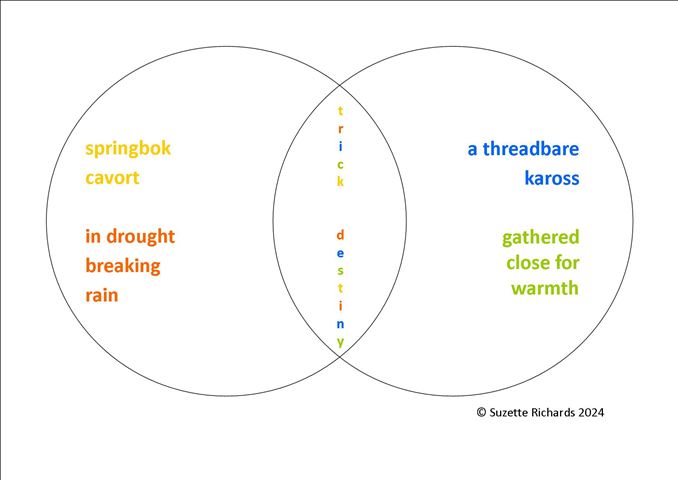Tanka prose is one type of prosimetrum, a literary composition that incorporates the two modes of writing, prose and verse; in this instance, it favours tanka as the verse component.
In haibun the haiku, the verse of choice, introduces a counterargument, juxtaposition, or a surprising twist, but it may also incorporate a reflection of one of the themes in the prose, or a complimentary detail. Unlike haibun, the technique is different in tanka prose.
‘An examination of the literature [...] does allow us to identify some common methods that writers of tanka prose employ in the segue. I [Jeffrey Woodward] use the term segue to underscore the fact that transitions in tanka prose lean towards compositional harmony, not dissonance. This trait runs counter to the character of close-related disciple, haibun, where the borders between prose and verse are frequently disjunctive and oblique.’ [1]
Segue or smooth transition between prose and tanka is a notable characteristic of contemporary tanka prose. Repetition and complement are techniques commonly used to achieve this end. The repeated figure can be (a) a keyword or phrase(e.g. anaphora) or (b) an element of sound (rhyme—this is less obvious: between phrases in the prose and tanka; consonance; assonance; or alliteration). Complement (or completion) occurs where prose and tanka are (a) joined in one sentence or syntactic unit or (b) written in such a way that one mode continues and completes the argument, theme or action initiated by the other mode. Although repetition and complement are the most common methods by which the desired segue is achieved, there are other methods at the poet’s disposal. Tanka Prose is titled. See my poem, The Fisherman at Churchhaven Lagoon.

Man in a Coracle, by Suzette Richards - image generated 19/2/2024
THE FISHERMAN AT CHURCHHAVEN LAGOON
The crying child wipes his nose on his mother’s grimy skirt which she had tried to wash this morning, but the ingrained dirt from the pulpy alluvium has permanently stained it russet-brown. She no longer noticed the malodour of the stagnant pool in the sluggish flowing river. She lights the cooking fire under the water bowl and has the handful of rice at the ready to add to the steaming basket. At least they would be eating fish tonight that her husband has caught.
sun at offing smarts
eyes of man in coracle
nearly worn out
dejected silhouette
evidence of life's phases
© Suzette Richards 2021 [edited 2024]
In the tanka prose above, I have used the recurring metaphor of the water bowl and coracle (sharing a common shape but they differ in purpose: the one holds water, whereas the other floats on the water). I confirm the image of fishing by using the word fish in the prose but using the implied metaphor in the tanka as this boat is chiefly used by fishermen.
The prose is imagistic and often carries the main theme of tanka prose. The tanka adheres to the basic requirements (see below), although poets have experimented with variations, notably, the line lengths, for example, the Sanford-style tanka which is a much truncated (in syllable count) format:[2]
Following are two examples of Sanford’s tanka, the first taken from This Tanka World (1977) and the second from the Tanka Society of America International Tanka Contest, 2003, where it won first place:
again
this catalogue
of past griefs
and I keep washing
the same dish
from my hospital window
I see across a bare field
in the morning rain
a yellow silk umbrella
on its solitary way
Tanka (short song) is a genre of a classical Japanese poem in five phrases; 31 syllables in total [5-7-5-7-7], though fewer are more usual nowadays. The more contemporary tanka poets favour the minimalist approach and are flexible insofar as the variable line lengths are concerned, allowing for similar line lengths. It has no metre; unrhymed (internal rhymes are acceptable); untitled; ‘usually entirely in lower case, except for proper nouns; and little, or no punctuation —sentence punctuation is really wrong’.[3] It is neither a sentence chopped into 5 lines, nor is it an extended haiku. It uses the 6 types of imagery* (one per tanka) to describe the different upper and lower phases, instead of an analytical approach, which may make it appear fragmented, for example, ‘it rains / I cry’. The first three lines are the upper phase (usually an image from nature in the first two lines), and the last two lines are the lower phase (the response). The fifth line is the punch line and is important!



The tanka portion of your poem could employ a turn, known as a pivotal image (a more gentle approach than the juxtaposition found in haiku), which marks the transition from the examination of an image to the examination of the personal response (from being objective to a subjective perspective), at line three. A syllepis (also known as zeugma), at line three, may be used where when read with the first 2 lines, and then with the last 2 lines, changes in meaning. In other words, it acts like a Venn diagram - see above. This pivotal image is not essential, as other poetic devices may be employed to mark the transition between the two phases, e.g. contronyms and homonyms and homonyms would work well here.
Metaphor, simile, or personification may be used in tanka. Ideally one would use recurring or extended metaphors in both the prose and tanka of the tanka prose to weave an interesting whole.
See my poem, ‘A Tree’—the Poem of the Day at PoetrySoup.com, dated 8 April 2023.
A Tree (poetrysoup.com)
*The 6 types of imagery: auditory, gustatory, kinetic, olfactory, tactile & visual.
[Edited 24/2/2024]
References
1.The Segue in Tanka Prose | New Zealand Poetry Society
2.Tanka Society of America - Spilling Tanka: An Interview with Sanford Goldstein
3.Problem of Tanka : De?nition and Differentiation - DocsLib